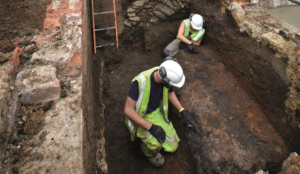Perhaps the most surprising object in the exhibit “Water Memories,” now at the Metropolitan Museum of Art in New York, is a denim jacket. It’s a Wrangler knock-off, with a red felt thunderbird on the back and a line of blue beads along the sleeves and waist.
Yet the exhibit is about the significance of water to Native American tribal nations, and how it is portrayed in their art. How does a jacket relate?
“The thunderbird is a sacred image to the Anishinaabe people,” said Patricia Norby Marroquin, curator of the exhibit. “It actually represents a thunder cloud.”
The beading represents water droplets, she said. The thunderbird and beading were added by the then-19-year-old Rick St. Germaine and his mother, Saxon St. Germaine, from The Lac Courte Oreilles Band of Lake Superior Chippewa Indians in Wisconsin.
Rick St. Germaine wore the jacket when he participated in the Native American occupation of the Winter Dam in Wisconsin in the early 1970s. Norby saw the jacket in a small midwestern museum and knew she needed it in the exhibit, because she wanted to represent different generations of Native Americans and examine how their art speaks to their activism around water.

This denim jacket, owned by Rick St. Germaine, represents thunder clouds – and also power. It was leant to the exhibit by the Chippewa Valley Museum.
Anna-Marie Kellen/Metropolitan Museum of Art, New York
Norby is Purépecha; her family is from a Pueblo in Mexico. She’s the museum’s first curator of Native American art and “Water Memories” is the first exhibition she’s put together at the Met.
“I think [the exhibit] beautifully reveals your indigenous and environmental approach,” said Sylvia Yount, the curator in charge of the museum’s American wing, to Norby, as they gave a tour.
Just a few years ago, Native American art at the museum was lumped together with art from places like Africa, Southeast Asia and South America. But in 2017, Charles and Valerie Diker promised the museum important gifts, donations and loans from their collection. As a result, the museum moved its Native American art to where it always belonged, Yount said: the American Wing.
“Water Memories” is a companion to the intricately-beaded clothing and other objects in the “Art of Native America” galleries. But “Water Memories” tells a story.
“As you go through the exhibition you’ll realize that what we are doing is creating a current, a stream of stories and memories,” Norby said.
The exhibit explores water’s many uses – for fishing, for travel, for ritual, for play. But it also points out how political water is. American power companies have flooded tribal land by building dams; a photograph by Cara Romero shows two Native Americans immersed in water, “still and suspended in a drowned landscape,” says the artist’s website. And a documentary-style video from Cannupa Hanska Luger shows a line of “water protectors” holding their mirrored shields at the Standing Rock Reservation. They glide across the snow to create a spiral – it represents a giant water snake.
Norby’s scholarship as an art historian is grounded in environmental activism, she said. Her research has focused on the connections between the agriculture industry, fine art, and water rights in the Southwest. Taking a political point of view may be new to the Met, she said, but not to her.
“I want people to leave with the understanding that we all have a role in protecting freshwater sources,” Norby said. “That we all have intimate ties to water, and that without fresh water we will not survive.”
All of the objects are connected to water in some way – the finely-crafted glass lamps once held oil that came from whales; the intricate baskets were made by softening the reeds in water. But the exhibit is in a fine arts museum, not an anthropological one, so there are plenty of gorgeous, provocative objects, like a canoe frame filled with feathers by Truman T. Lowe; a triptych of a beach landscape with a sinister, dark angel in its center by Fritz Scholder; and a pile of what looks like shiny, hollow, whale teeth on a weathered dock.
That piece, by the Shinnecock artist Courtney M. Leonard, is one of Norby’s favorites, because of how deeply personal it is. And she loves the aesthetics of those teeth.
“They glow. They’re beautiful. They’re pearlescent. You want to almost want to reach out and touch them because of their their smooth texture,” she said. Then she laughed. “But we highly recommend that people do not do that here at the museum.”

The painting “Possession on the Beach” by Fritz Scholder looms over a glossy pile of whale teeth, called “BREACH Logbook 22 | BREACH # 2” by Courtney M. Leonard
Anna-Marie Kellen/Metropolitan Museum of Art, New York




